Are zombie movies and fun-size candy bars getting a bit old? Look no further than some of the quirky and mysterious plants of California to get into the Halloween spirit Bay Nature-style.
The Poisoners:
1. Bluewitch nightshade (Solanum umbelliferum)

This little ‘witch’ is native to California with beautiful blue flowers, a striking yellow center, and an ability to survive just about anything. It also happens to be in the same family as our edible garden nightshades, like tomatoes, eggplants, and potatoes—but don’t get tricked! The fruits, which resemble tiny tomatoes, are incredibly toxic, along with the rest of the plant.
2. Poison oak (Toxicodendron diversilobum)
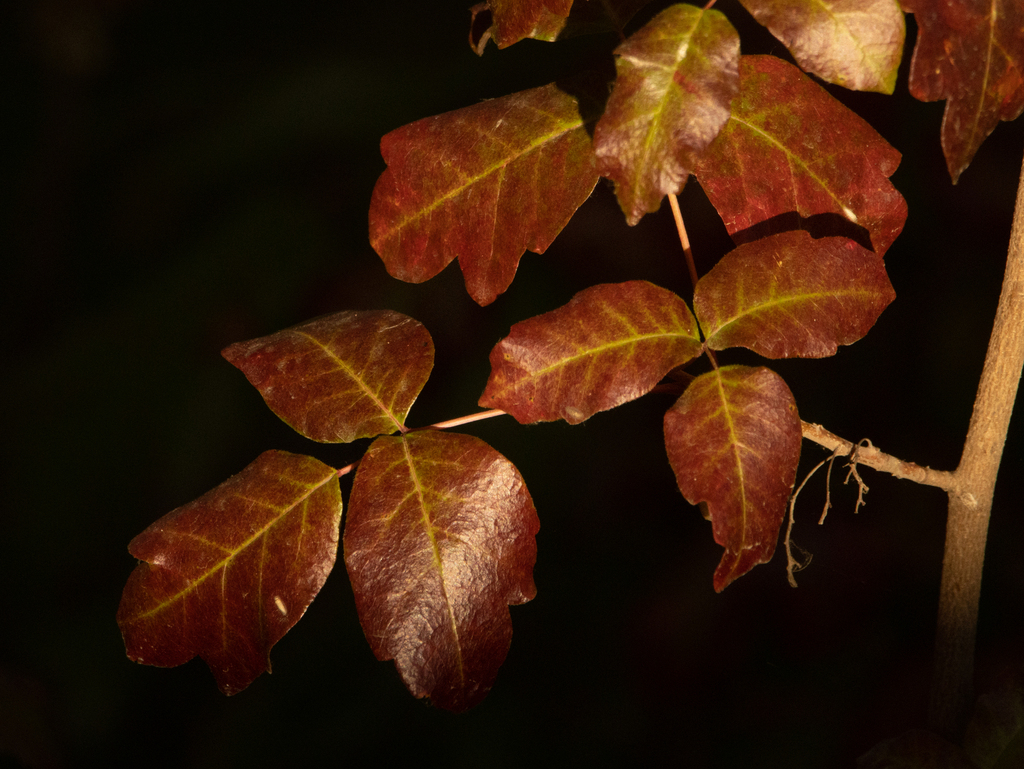
Those who say we don’t have seasons in California aren’t hiking through enough poison oak. We may not experience the sprawling hillsides of fall foliage that New England boasts, but we do get swaths of festive color as the leaves of poison oak turn crimson, before they drop from their itch-inducing bare stems.
This plant may terrorize people, but is an incredible habitat plant for most animals, especially birds. While deer enjoy the leaves, birds feast on the berries and use the dense vegetation as cover in spring and summer. Bees, both native and non-native, enjoy the pollen and nectar of the small, white flowers, and honeybees can make a bitter honey out of the plant. Personally, I think the little flowers are adorable and smell a bit like cinnamon (but test that out at your own peril).
Ask almost anyone who hikes or enjoys the outdoors in the Bay Area about poison oak, and they will likely have a story for you (either about a terrible rash, or a near miss, or for the lucky few … a boastful tale about immunity). And indeed, this plant is embedded in California’s history. Los Angeles is built on the site of a Gabrielino Indian village whose name, Iyáanga’ (according to the linguist William Bright), translates as “poison-oak place.” The plant was often eaten by many Bay Area tribes, both for flavor and to encourage immunity.
This plant is truly a force to be reckoned with: some 50–75 percent of the adult population is sensitive to urushiol, the toxic oil in poison oak, and 25 to 40 million patients require medical treatment for reactions each year. The pollen does not contain urushiol, but the leaves can hold it for a long time; even old herbarium samples have been known to cause rashes. An outstandingly successful first-succession plant, poison oak also thrives amid excess carbon dioxide, so is expected to be a climate change winner.
3. Poison hemlock, Conium maculatum

The only invasive species on this list, hemlock hails from Europe and is infamously the plant that killed Socrates. Although it’s in the carrot family, don’t dare take a bite, as all parts of this plant are incredibly toxic to animals and people. Even touching it can cause contact dermatitis in some people. The toxicity is due to several alkaloids, which researchers theorize may play a part in attracting pollinators. Often found growing in disturbed soil, hemlock is easy to spot—look for the blood-red to purplish streaks down the stem.
The Vampires:
4. California dodder (Cuscuta californica)
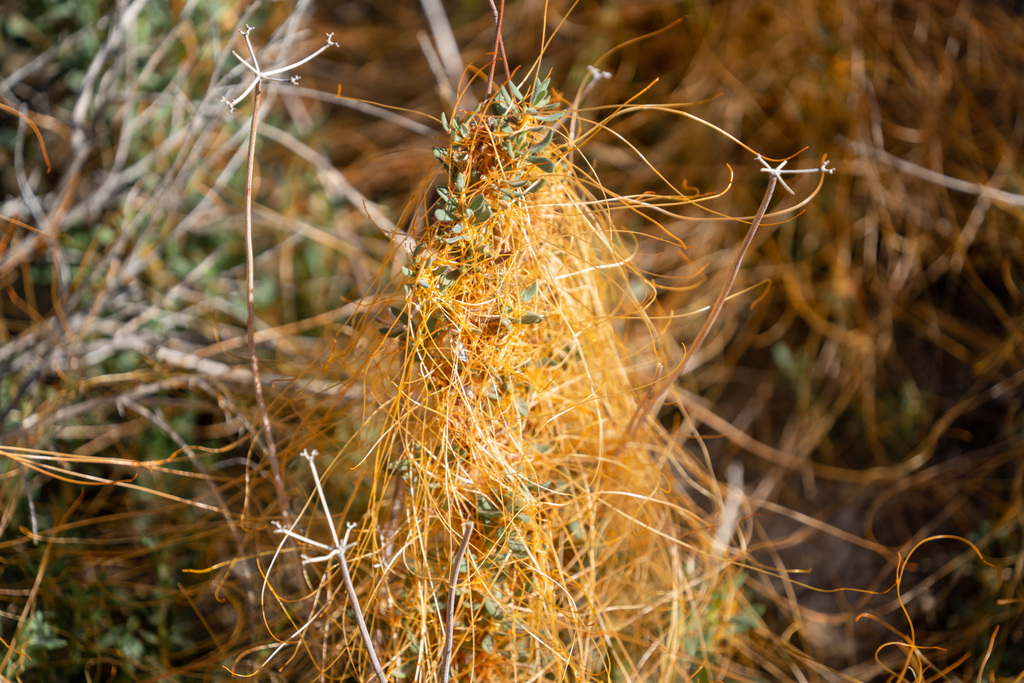
The first time I saw this plant I thought it was silly string or fish netting. The color is surreal, especially in contrast to green vegetation. This neon-orange parasitic vine, a morning-glory cousin, also boasts a variety of seasonally appropriate common names: witch’s hair, strangle-weed, devil’s hair, devils sewing thread, and hell-bind, just to name a few.
As the Day-Glo or Cheeto color might indicate, the vine does not produce its own chlorophyll. Instead, it sucks nutrients and moisture from its host plant, although it rarely kills its host, opting to slowly suck out what it needs before senescing for the season. Host plants for this species include buckwheat, verbanas, fern, milkweed, and ragweeds, among others. The emerging seedling uses its haustorium, a modified rootlike structure, to tap into its host, and, researchers have concluded that the dodder can sense and selectively choose its host plants.
5. American mistletoe (Phoradendron leucarpum); Oak mistletoe (Phoradendron leucarpum ssp. tomentosum)
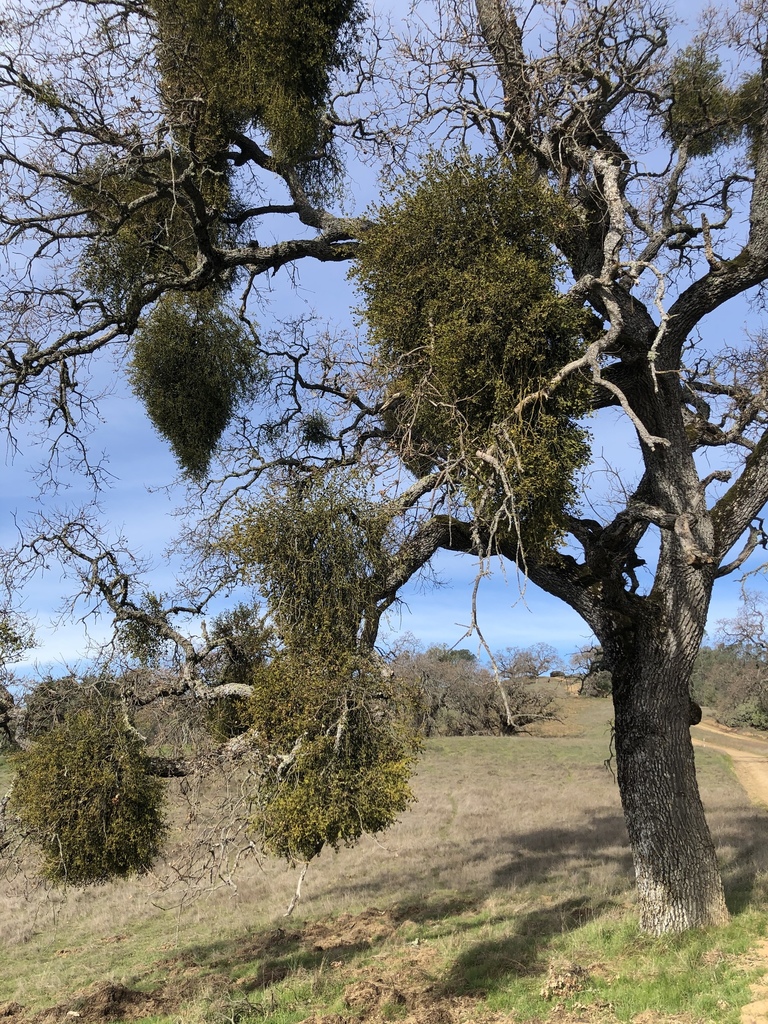
Nightmare before Christmas, anyone? While there are 1,200 or so species of mistletoe found around the world, the most common in our region is the hemi-parasitic oak mistletoe. Like dodder, it leaches water and minerals from its host, but unlike dodder it bothers to produce its own chlorophyll, as you can tell from its fleshy green leaves. The succulent leaves help the parasite stay one step ahead of its host, facilitating massive water storage potential, and even drawing water toward the mistletoe ahead of its host. The Latin root of its genus name, Phoradendron translates to “tree thief.”
People used to think mistletoes all hurt their host plants, and they can if they get out of control, but now we know they’re not really villains. In fact, they are often a keystone species, and if native mistletoe is removed it can result in a one-third loss of fauna. A thicket of dense branches that grows the mistletoe’s attachment point is often referred to as a witch’s broom. If you peer up at the green, globe-like masses with binoculars, you can often find animals—hummingbirds, raccoons, and songbirds, among many others—snoozing in them, nesting in them, or otherwise using them as habitat.
Mistletoe seeds are spread through bird droppings and will only reach maturity if the seedling happens to be growing near a tree’s bud, leaf, or branch. In fact, the name mistletoe is derived from the Anglo-Saxon words mistel, which means dung, and tan which means stick, in reference to this messy propagation process. The seeds emit a natural glue called viscin that helps them stick to trees. If conditions are just right, it will germinate, and like the dodder, use its haustorium to break into its host plant as an entry point for nourishment (not entirely unlike the pivotal moment in any zombie movie when the first victim is bitten—something to ponder at upcoming Christmas parties!). To top it all off, the plant is highly toxic and eating its berries can cause vomiting, nausea, or even death.
So where does the Christmas connection come into play? One possibility: in Nordic mythology, the trickster-god Loki shot and killed Baldur, son of the love-goddess Frigga, with a mistletoe arrow. Frigga brought her son back to life beneath a mistletoe, and declared that anyone who stands under mistletoe shall receive both protection from death and a bonus kiss. Historically, it has also been used to ward off ghosts and witches, among myriad other practical and fanciful uses.
The Underground Robbers:
6. Ghost pipe (Monotropa uniflora)

A ghostly, translucent white flower found only sporadically in the darkest corners of the forest floor, you will have to travel a little further afield, up to the thickest redwood forests of Humboldt and Del Norte Counties, to catch a glimpse of this mysterious little plant.
Ghost pipe is heterotrophic, meaning it doesn’t make its own food, and what’s more, it’s in a special class called mycotrophs that tap into the nutrients of other plants belowground. It attaches itself to the underground mycorrhizal networks of fungi, which are in turn affixed to the roots of their host plant. In other words, it sneakily obtains nutrients through the host plant via the fungi. Kind of like using your ex’s sister’s Netflix account without her knowing.
While this flower has a limited range in California, it is present throughout the darkest woods of the United States, excluding the southwest. Emily Dickinson wrote about it in a letter: “I still cherish the clutch with which I bore it from the ground when a wondering child, and unearthly booty, and maturity only enhances the mystery, never decreases it.”
7. Gnome plant (Hemitomes congestum)
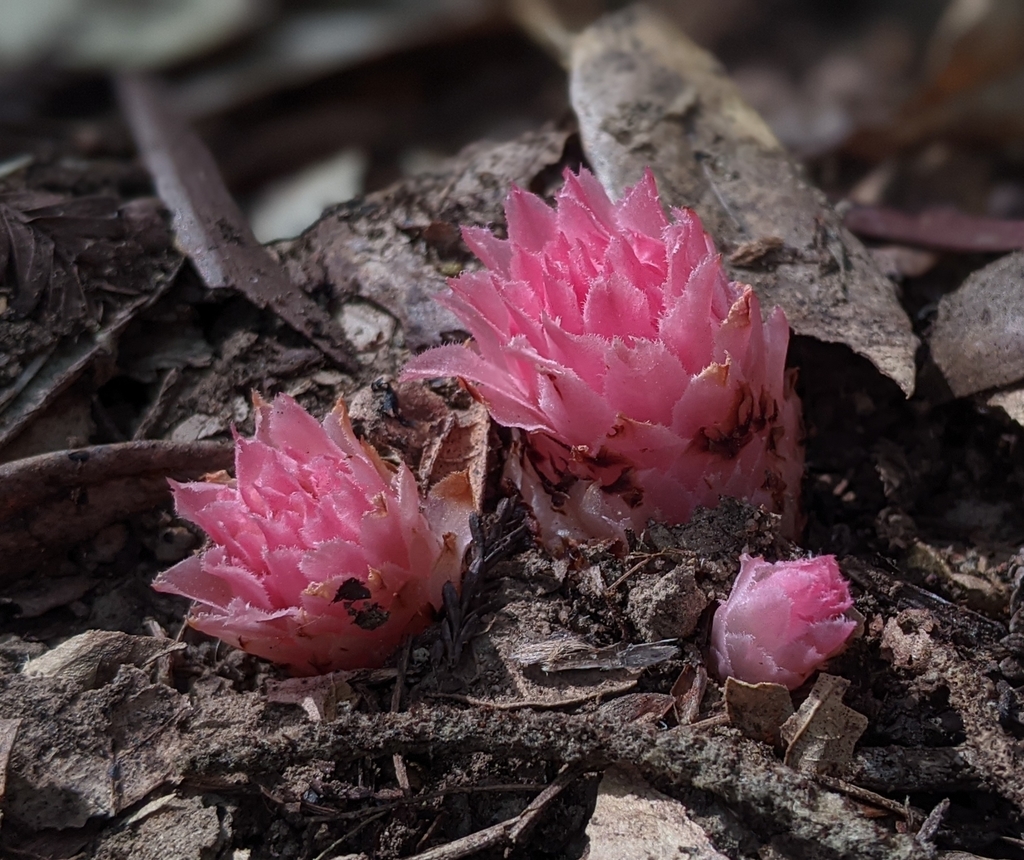
Described by US Forest Service as a “fleshy lump in the leaf litter” of the dark forest understory (thanks for the nightmare fuel, USFS). It’s difficult to find due to its small stature at only 2–10 cm tall and incredible rarity. Much of the plant’s life cycle is still a mystery. Like the ghost pipe, it’s a mycotroph.
You can try your luck to find it in old-growth coastal forests from Monterey County all the way up to British Columbia. Look for a pale-white to yellow to light-pink lump, with jagged scales that are really modified leaves. Notably, its fruit has a musky odor, not unlike pungent cheese, often found spread across the forest floor, though researchers still aren’t sure what animal eats it.
The Snatcher:
8. Dutchman’s pipevine (Aristolochia californica)

Dutchman’s pipevine seems like an innocuous enough plant, with its funny-looking flower, until you learn about its pollination technique. When the flower reaches maturity, it releases the scent of rotting meat to attract fungus gnats and other carrion-loving insects. The unsuspecting gnats are held hostage inside the cavity of the flower, unable to find their way out of the complicated structure and all the while unassumingly gathering pollen during their quest for their escape. Some gnats perish, some lucky ones find their way out, and some escape when the flower wilts. Once free, most gnats fall for another rotten-meat scented pipevine flower and thus do the plants’ bidding, pollinating as they go. These plants were once thought to be insectivorous, but that’s disproven now that we know they pollinate by deceit.
Dutchman’s pipevine seems like an innocuous enough plant, with its funny-looking flower, until you learn about its pollination technique. When the flower reaches maturity, it releases the scent of rotting meat to attract fungus gnats and other carrion-loving insects. The unsuspecting gnats are held hostage inside the cavity of the flower, unable to find their way out of the complicated structure and all the while unassumingly gathering pollen during their quest for their escape. Some gnats perish, some lucky ones find their way out, and some escape when the flower wilts. Once free, most gnats fall for another rotten-meat scented pipevine flower and thus do the plants’ bidding, pollinating as they go. These plants were once thought to be insectivorous, but that’s disproven now that we know they pollinate by deceit.
And Two Freaky Fungi:
9. Bleeding tooth fungus: Hydnellum peckii
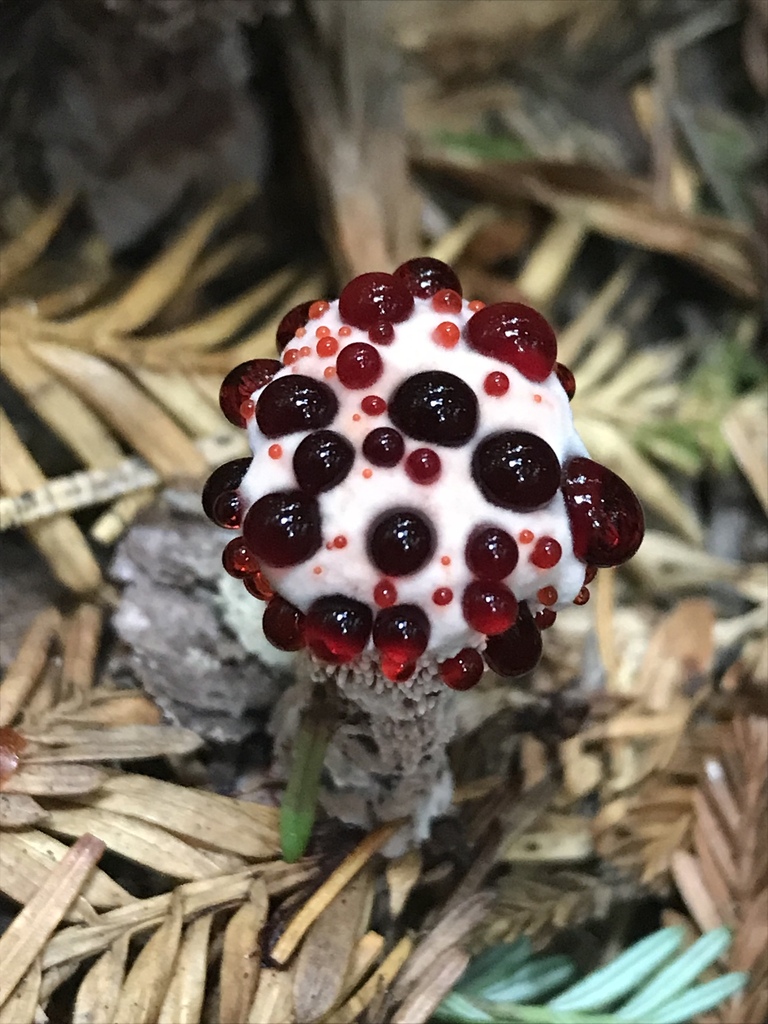
Bleeding tooth or devil’s-tooth fungus is noteworthy for the bright-red droplets, resembling blood, dotting the surface of its flesh-colored or white emergent mushrooms. The red fluid is likely a sap of sorts that “bleeds” whenever soil moisture increases pressure within the mycelial system and forces the mushroom to exude the red liquid. Mysteriously, mycologists still debate about what the liquid is exactly, beyond a sort of “sap”. Notably, this mushroom may contain anticoagulant and anti-bacterial properties. The mushroom is also prized by natural dyers, who make brown or blue-green colors from it.

10. Jack-o-lantern mushroom (Omphalotus olivascens)
A poisonous mushroom that is pumpkin-orange by day and glows in the dark by night. It’s a chanterelle and honey-mushroom look-alike, and many novice mushroom foragers have been tricked—but the gills will tell the truth! (Chanterelles have false gills that are like wavy ridges.) In the dark, the jack-o’-lantern’s gills glow blue-green due to the compound luciferase.





